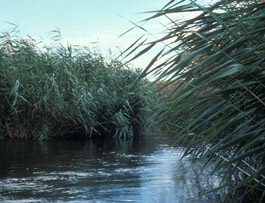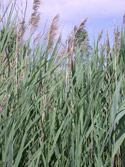Common Reed
Phragmites australis • Class B |
||
| Family Name: | Poaceae family (poh-AY-see-ee) | |
| Common: | Grass family | |
| Genus: |
Phragmites (frag-MY-tees) Meaning: A screen or temporary defense |
|
| Species: |
australis (aw-STRAL-iss) Meaning: Of or from the south, or Australia |
|
| Description: |
Phragmites or common reed is a very large, perennial grass that grows up to 15 feet tall. It has large hollow stems, which produce leaves up to 16 inches long along most of their length. Short papery bracts, called ligules, grow from the leaf where it bends out from the stem and are yellow or greenish in color. It produces dense feathery flower heads 8 to 16 inches long. |
| Why Is it a Noxious Weed? |
Common reed will colonize and displace the other plants in a wetland community, often forming dense monocultures. It displaces wildlife because it alters the wetland environment so dramatically. Water quality is also deteriorated, because water flow or circulation is adversely affected by this species. |
| Where Does it Grow? |
Seedlings may be produced on nearly any site that has some surface water, even brackish or salt water. It is typically found in or near wetlands. |
| Facts: |
Below the water line, the plant’s root system secretes an acid so toxic that it causes the protein structure in nearby plant roots to rot away, killing off all neighboring plant life so that it can spread to new areas. |
| Control Options: |
|
| More Information: |
For more information on this noxious weed Download our Flyer or visit Washington State Noxious Weed Control Board Here
|
| More Pictures: |



